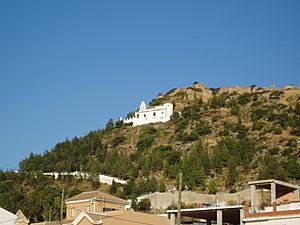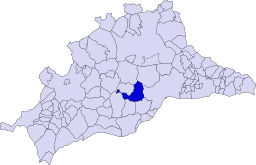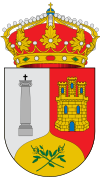Cártama facts for kids
Quick facts for kids
Cártama
|
|||
|---|---|---|---|

The Hermitage of Cártama
|
|||
|
|||
 |
|||
| Sovereign state | |||
| Autonomous community | |||
| Province | |||
| Comarca | Valle del Guadalhorce | ||
| Area | |||
| • Total | 150.12 km2 (57.96 sq mi) | ||
| Elevation
(AMSL)
|
96 m (315 ft) | ||
| Population
(2018)
|
|||
| • Total | 25,758 | ||
| • Density | 171.583/km2 (444.397/sq mi) | ||
| Demonym(s) | Cartameños | ||
| Time zone | UTC+1 (CET) | ||
| • Summer (DST) | UTC+2 (CEST) | ||
| Postal code |
29570-29580
|
||
| Area code(s) | (+34) 952 | ||
| Vehicle registration | MA | ||
| Website | www.cartama.es | ||
Cártama is a cool town and area in southern Spain. It's part of the province of Málaga in the Andalusia region. Cártama is about 17 kilometers (10.5 miles) from the big city of Málaga. It's one of the largest towns in its province, covering about 150 square kilometers (58 square miles). Around 25,758 people live in Cártama.
Contents
Exploring Cártama's Geography
Cártama is located in the middle of the Guadalhorce valley. It sits at the base of two small mountain ranges. The area is famous for its many orange and lemon trees. Cártama is about 17 kilometers from the main city of Málaga.
The town spreads out on both sides of the Guadalhorce river. From a high point called the Hill of the Virgin, you can see different parts of the town. These include Cártama Pueblo, Estación de Cartama, El Sexmo, Doñana, Aljaima, and Sierra de Gibralgalia.
Cártama Pueblo: The Old Town
Cártama Pueblo is the oldest part of the town. It has a history of 3,000 years. Its streets are designed in an old Moorish style. This part of Cártama is built on the steep side of the Hill of the Virgin. The buildings and roads follow the shape of the hill.
Estación de Cartama: A Railway Town
Estación de Cartama grew around a railway station. This station was built in 1865.
The Green Bridge: A Local Landmark
One well-known feature is the iron bridge over the Guadalhorce river. People call it the "green bridge" or puente verde. This bridge used to connect Estación and Cártama Pueblo. Now, a more modern road bridge is used. The old bridge area has been made into a fun place for people to visit. There are plans for a large riverside recreation area too.
Cártama's Rich History
Cártama has always been an important place. It sits on a natural path from the coast to inland areas. Many different groups of people have lived here over time. These include the Iberians, Tartessians, Phoenicians, Romans, Visigoths, Byzantines, and Arabs.
Ancient Beginnings: Phoenicians and Romans
The Phoenicians were already in Málaga. They traveled inland along the river. They gave Cártama its first known name, Cartha. This name means "hidden city." Later, the Romans arrived. They renamed it Cartima and built the town in 195 BC. They added strong defenses to the town.
The Roman rule lasted for 600 years. During this time, Cartima was a very important town. Many old Roman things have been found here. These include mosaics, sculptures, burial sites, and old roads. This shows that many people lived here. The baths of Cartima were also famous. People believed they had healing powers.
Christian Conquest and Moorish Strongholds
Cártama was one of the last Moorish strongholds in the area. It was finally taken by Christian armies in 1485. This happened during the time of King Ferdinand the Catholic.
Must-See Sights in Cártama
Cártama has several interesting places to visit. They show the town's long history.
Hermitage of Our Lady of the Remedies
The Hermitage of Our Lady of the Remedies (La Ermita de Nuestra Señora de los Remedios) is on the Hill of the Virgin. It's a very old and important building. It was built where an older hermitage from the 1400s once stood. The hermitage is beautiful. The path to it winds up the hill. From there, you get amazing views of the whole area.
The Humilladero Cross: A Roman Column
You can still see a column from the Roman period. It's from the 2nd century AD. It's called the Humilladero Cross. It has an iron cross on top. This column is a key reminder of the old Roman town, "Cartima Municipium." That's why it's on the town's heraldic crest. It was moved to its current spot in 1752. This was to mark old digs by the Marquis de Valdeflores.
Cártama Castle: A Historic Fortress
The castle in Cártama dates back to the 10th century. This was when the Moors ruled the city. It sits on a high ridge. From here, you can see amazing views all around. Between the 1200s and 1400s, it was a very important defense for Málaga. It guarded against attacks coming from the Guadalhorce valley.
The castle was built like a military fort. It had two sets of walls. The first wall had ten towers. The second wall, closer to town, had eight towers. It also had another walled tower. The castle was ready for long sieges. It had two wells dug during the time of the Caliphs. The capture of the castle by the Catholic Monarchs in 1485 is shown in the Cathedral of Toledo. This shows how important Cártama was back then. After the Christians took Málaga, the castle slowly fell apart.
Church of Saint Peter the Apostle
The Church of Saint Peter the Apostle was built where an old mosque used to be. This happened after the Christians took the city. The church is still standing today. It has been recently fixed up and looks great.
Famous People from Cártama
Cártama is home to some notable people.
José González Marín: The Poet
On Calle Viento, you can find the house of the poet José González Marín. He was born in Cártama in 1889. He also passed away there in 1956.
Jose Alarcon Lujan: A Local Figure
Also on Calle Viento is the house of Jose Alarcon Lujan. He was born in Cártama in 1821 and died there in 1902. His house is a beautiful old mansion. It still shows the amazing architecture of that time.
Cártama's Lively Traditions and Festivals
Cártama is well-known for its many festivals and ferias. These events bring the town to life.
Carnivals and the Main Festival
The carnivals happen in February. But the biggest festival of the year is in April. It honors the town's patron saint, La Virgen de los Remedios. The statue of the Virgin is carried down the mountain. It goes from its chapel in the Ermíta to the Church of Saint Peter the Apostle.
On April 23, the Virgin is paraded through the town. People come from far away, even from other countries, to see this procession. They also bring offerings. After the festival, there is a cattle fair. This festival has recently been named a "Fiesta of National Touristic Interest."
Estación's San Isidro Feria
In May, Estación holds its own fair. This celebrates the Saint's Day of its patron, San Isidro. The most exciting part is a big parade. The saint's image is carried to the banks of the River Guadalhorce. A celebration is held there all day. Prizes are given for the best decorated street.
Verdiales Festival: Music and Dance
On the first Sunday in May, Cártama hosts the Verdiales festival. This is a traditional country song and dance event. Groups from nearby towns like Álora, Pizarra, Almogía, and Cártama take part. This event is held at the Ermita de las Cruces. It has also been called an "Event of National Tourist Interest."
Other Annual Events
Cártama has many other yearly events.
- The Virgin returns to the Ermita in early June.
- The festival of San Juan is in late June.
- The September Cattle Fair is another big event.
- The El Sexmo fair lasts for four days in the second week of September.
- The Día de los Canastitos is on Saint Ann's day. It's held by the Río Grande. People bring baskets of fruit and bread. The Verdiales music features old wheel dances.
See also
 In Spanish: Cártama para niños
In Spanish: Cártama para niños




